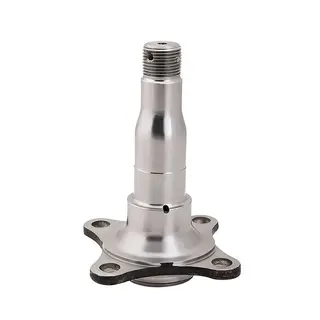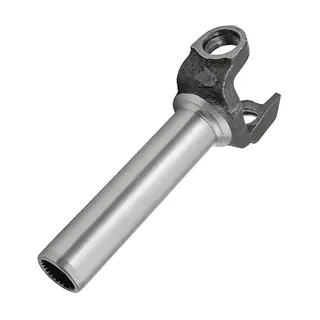In the field of industrial manufacturing, stainless steel forgings are widely used in various high-end equipment and structures due to their excellent corrosion resistance, strength, and aesthetic appeal. However, these superior properties are not inherent when stainless steel forgings leave the factory; rather, they are carefully developed through a series of complex heat treatment processes. This article will provide an in-depth discussion of stainless steel forging heat treatment techniques, helping you understand how this key process enhances the performance of stainless steel forgings, enabling them to meet various demanding application requirements.
Stainless steel is a special type of steel, with main components including high contents of nickel, chromium, and other alloying elements. These elements give stainless steel unique physical and chemical properties, but they also make its heat treatment process different from ordinary steel. The main purpose of stainless steel heat treatment is to modify its physical properties, mechanical properties, and residual stress, and to restore corrosion resistance affected by prior processing and heating. Through heat treatment, stainless steel can achieve ideal performance for use, or prepare for further cold or hot processing.
Stainless steel heat treatment processes are diverse, mainly including annealing, quenching and tempering, and normalizing. Each process has its specific purpose and applicable scenarios. For example, for forgings produced from stainless steels and heat-resistant steels that cannot be strengthened by heat treatment, if the goal is to improve corrosion resistance and plasticity and eliminate work hardening, solution treatment is the best choice. For complex-shaped forgings where solution treatment may be difficult, stress-relief annealing is a feasible alternative. For titanium- or niobium-containing stainless steel forgings, stabilization annealing is essential to obtain stable corrosion resistance.
There are many types of stainless steel, each with its unique microstructure and performance characteristics. Therefore, different heat treatment methods are required to achieve optimal performance. Understanding these differences is crucial for selecting suitable stainless steel materials and formulating reasonable heat treatment processes. Let us explore these in detail.
Austenitic stainless steel is the most widely used type of stainless steel. It has an austenitic structure at room temperature and does not undergo phase transformation, so it cannot be hardened by heat treatment, but it can be strengthened by cold working. Typical representatives are 304 and 316 stainless steels.
The commonly used heat treatment method for austenitic stainless steel is solution treatment. The main purpose of solution treatment is to dissolve carbides into the austenitic matrix, and then fix them in the matrix through rapid cooling, thereby obtaining a uniform austenitic structure. This can improve the corrosion resistance and plasticity of stainless steel, while eliminating residual stress generated during cold working.
The process parameters of solution treatment have a crucial impact on the final performance. Generally, the solution treatment temperature ranges from 1050℃ to 1150℃, depending on the stainless steel composition. Heating time is usually determined by the size and shape of the forging to ensure the entire piece reaches the solution temperature uniformly. During cooling, rapid cooling (such as water cooling or air cooling) is key, as this prevents carbide re-precipitation during cooling, thereby maintaining good corrosion resistance.
Ferritic stainless steel maintains a ferritic structure at both high and room temperatures and does not undergo phase transformation. This type of stainless steel generally contains higher chromium content but no nickel. Due to its structural characteristics, ferritic stainless steel cannot be strengthened by heat treatment and can only undergo annealing to relieve internal stress and facilitate further processing.
The main purpose of annealing is to reduce hardness, increase plasticity, refine grains, and produce a uniform microstructure, preparing the material for subsequent processing. The annealing temperature of ferritic stainless steel is generally between 750℃ and 850℃, depending on steel composition and the desired hardness. Cooling after annealing is relatively slow, usually furnace cooling, to avoid generating new internal stress. This process reduces the hardness of ferritic stainless steel to a level suitable for processing while maintaining good corrosion resistance.
Martensitic stainless steel has a clear phase transformation point: it exists as austenite at high temperature and can transform into martensite during cooling, thus achieving hardening. Typical representatives are 410 and 420 stainless steels. Due to high chromium content and good hardenability, various heat treatment methods such as quenching and tempering can be used to increase strength and hardness.
Quenching is a key step in the heat treatment of martensitic stainless steel. The quenching temperature is usually between 950℃ and 1050℃, depending on the steel composition and the desired hardness. The cooling rate after quenching is very fast, usually oil or air cooling, to ensure the formation of martensite. Quenched martensite has very high hardness but also considerable brittleness, so tempering is required to adjust hardness and toughness. Tempering temperatures typically range from 200℃ to 600℃, depending on the desired mechanical properties. Low-temperature tempering (200℃–350℃) achieves high hardness and good wear resistance, medium-temperature tempering (350℃–500℃) results in higher strength and yield, and high-temperature tempering (500℃–600℃) provides good toughness and corrosion resistance.
Selecting the appropriate heat treatment process is crucial for the final performance of stainless steel forgings. Different application scenarios have different performance requirements, so it is necessary to choose the heat treatment process according to specific needs.
For stainless steel forgings that require high strength and hardness, quenching followed by low-temperature tempering is the best choice. This method maintains high hardness while adjusting toughness through low-temperature tempering, allowing the part to withstand greater loads. For example, parts such as SS 410 drill screws requiring high hardness typically undergo this heat treatment.
For stainless steel forgings that require excellent corrosion resistance, solution treatment is the first choice. Solution treatment dissolves carbides into the austenitic matrix, thereby improving corrosion resistance. For example, SS 304 and 316 typically undergo solution treatment to ensure performance in various corrosive environments.
For stainless steel forgings that require the elimination of residual stress from machining, annealing is an effective choice. Annealing reduces hardness, increases plasticity, and relieves internal stress, preventing deformation and cracking. For example, stainless steel sheets or bars after cold rolling or stretching usually need annealing to prepare for the next cold processing step.
For stainless steel forgings that require improvement of the original microstructure, preparatory heat treatment of normalizing followed by high-temperature tempering is effective. Normalizing refines grains and produces uniform structure, while high-temperature tempering adjusts hardness and toughness, preparing the material for subsequent processing.
Precipitation-hardened stainless steel is a special type that can further improve strength and corrosion resistance through heat treatment. The heat treatment process includes solution treatment plus aging, solution treatment plus cold treatment, or cold deformation plus aging. These processes allow the stainless steel to precipitate strengthening phases during aging after solution treatment, thereby increasing strength and hardness while maintaining corrosion resistance.
Although stainless steel heat treatment can significantly improve performance, there are key points to note during actual operations to ensure effectiveness and quality.
Stainless steel requires high heating temperatures and relatively long heating times because of its low thermal conductivity. Sufficient time is needed to ensure the entire forging reaches the required temperature uniformly. During heating, it is critical to control temperature and time to avoid overheating or underheating. Overheating may cause grain growth, reducing mechanical properties, while underheating fails to achieve the desired heat treatment effect.
Furnace atmosphere significantly affects heat treatment outcomes. During heating, stainless steel is prone to carburization, nitriding, decarburization, and over-oxidation, which can seriously affect surface quality and corrosion resistance. Therefore, strict control of furnace atmosphere is necessary, typically using protective gases (such as argon or nitrogen) or a vacuum environment to prevent these issues.
Surface finish affects both the usability and price of stainless steel. Oxidized scales formed during heat treatment can severely impact surface gloss. Therefore, appropriate post-treatment such as pickling or sandblasting is needed to remove scales and restore surface luster.
During heat treatment, it is important to protect the surface from scratches and prevent deformation. Proper support and fixation measures during heating and cooling are necessary to maintain the forging's shape and dimensional accuracy.
Through proper heat treatment processes, the performance of stainless steel forgings can be significantly improved. The enhancements include:
Cold-worked stainless steel forgings develop work hardening, increasing hardness and reducing plasticity. Annealing eliminates work hardening, restoring ductility for further cold processing. For example, stainless steel sheets stamped into troughs on an 800-ton hydraulic press can avoid tearing during stamping after annealing.
Solution treatment dissolves carbides into the austenitic matrix, enhancing corrosion resistance. For instance, 304 stainless steel exhibits significantly improved corrosion resistance after solution treatment, better resisting various corrosive media.
Quenching and tempering adjust hardness and toughness. Quenching plus low-temperature tempering achieves high hardness and wear resistance, while quenching plus high-temperature tempering provides good toughness and corrosion resistance. This allows stainless steel forgings to achieve optimal mechanical properties based on application needs.
Annealing effectively relieves residual stress in stainless steel forgings. If not removed, these stresses may cause deformation or cracking during subsequent processing or use. Annealing ensures dimensional stability and reliability.
Heat treatment is a key process for enhancing the performance of stainless steel forgings. Proper heat treatment significantly improves corrosion resistance, strength, toughness, and plasticity, while eliminating machining stress to ensure dimensional stability and reliability. Different types of stainless steel and application scenarios require suitable heat treatment processes, such as solution treatment, quenching plus tempering, and annealing. During heat treatment, attention must be paid to heating temperature and time, furnace atmosphere control, surface treatment, and preventing deformation or scratches to ensure effective and high-quality results. Understanding the heat treatment processes of stainless steel forgings enables better selection and application of stainless steel materials, meeting complex application requirements and contributing to greater success in stainless steel manufacturing and utilization.



